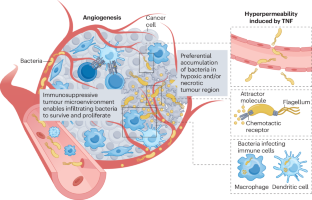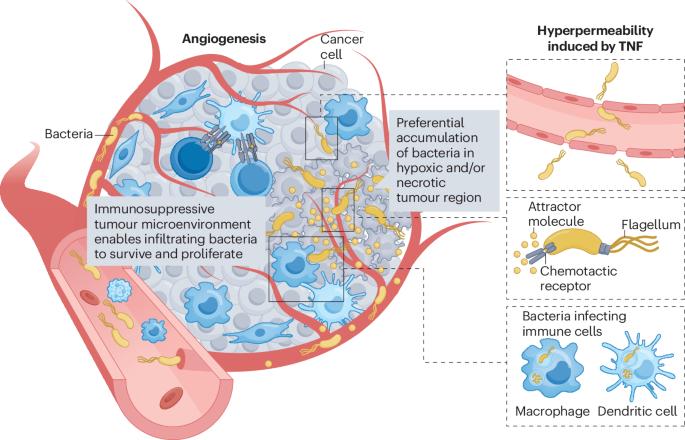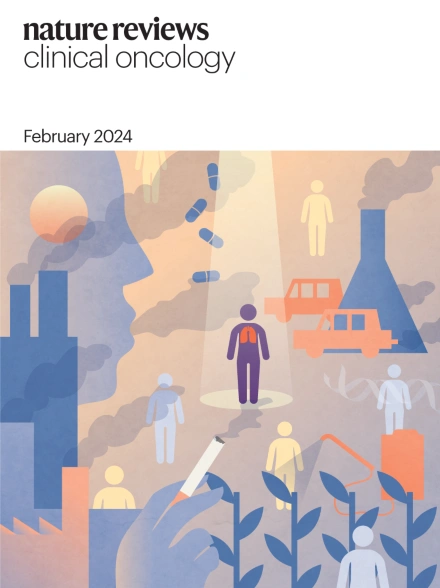利用细菌进行癌症免疫疗法
IF 81.1
1区 医学
Q1 ONCOLOGY
引用次数: 0
摘要
免疫疗法为癌症治疗带来了革命性的变化,但仍然受到反应率有限、获得性抗药性、毒性和高成本的制约,因此有必要开发新的创新策略。人类微生物群与癌症之间联系的发现可以追溯到 4000 年前,当时人们观察到局部感染会导致一些人的肿瘤被根除。然而,直到二十世纪之交,人们才认识到肿瘤内微生物群与肿瘤的真正相关性。肿瘤内微生物群在癌症的发病和治疗过程中都起着举足轻重的作用。特别是,肿瘤内细菌可通过重塑肿瘤微环境促进或抑制癌症生长。在过去二十年中,将细菌作为癌症免疫疗法制剂的临床前研究取得了显著进展;其中一些细菌产品已成功进入临床开发阶段。在本综述中,我们将讨论肿瘤内细菌的特性及其与肿瘤微环境之间错综复杂的相互作用。我们还介绍了许多用于治疗癌症的细菌工程策略,总结了已完成和正在进行的临床试验的当代数据。本文介绍的工作凸显了细菌改变癌症治疗格局的潜力,将古代智慧与现代科学创新融为一体。本文章由计算机程序翻译,如有差异,请以英文原文为准。


Exploiting bacteria for cancer immunotherapy
Immunotherapy has revolutionized the treatment of cancer but continues to be constrained by limited response rates, acquired resistance, toxicities and high costs, which necessitates the development of new, innovative strategies. The discovery of a connection between the human microbiota and cancer dates back 4,000 years, when local infection was observed to result in tumour eradication in some individuals. However, the true oncological relevance of the intratumoural microbiota was not recognized until the turn of the twentieth century. The intratumoural microbiota can have pivotal roles in both the pathogenesis and treatment of cancer. In particular, intratumoural bacteria can either promote or inhibit cancer growth via remodelling of the tumour microenvironment. Over the past two decades, remarkable progress has been made preclinically in engineering bacteria as agents for cancer immunotherapy; some of these bacterial products have successfully reached the clinical stages of development. In this Review, we discuss the characteristics of intratumoural bacteria and their intricate interactions with the tumour microenvironment. We also describe the many strategies used to engineer bacteria for use in the treatment of cancer, summarizing contemporary data from completed and ongoing clinical trials. The work described herein highlights the potential of bacteria to transform the landscape of cancer therapy, bridging ancient wisdom with modern scientific innovation. Increasing evidence indicates that intratumoural bacteria can have crucial roles in both the pathogenesis and treatment of cancer. In this Review, the authors discuss the characteristics of intratumoural bacteria and the emerging understanding of their tumour-promoting and antitumour activities. They also describe a range of innovative strategies that are being used to engineer bacteria for use in the treatment of cancer and summarize clinical trials of various bacteria-mediated cancer immunotherapies.
求助全文
通过发布文献求助,成功后即可免费获取论文全文。
去求助
来源期刊
CiteScore
99.40
自引率
0.40%
发文量
114
审稿时长
6-12 weeks
期刊介绍:
Nature Reviews publishes clinical content authored by internationally renowned clinical academics and researchers, catering to readers in the medical sciences at postgraduate levels and beyond. Although targeted at practicing doctors, researchers, and academics within specific specialties, the aim is to ensure accessibility for readers across various medical disciplines. The journal features in-depth Reviews offering authoritative and current information, contextualizing topics within the history and development of a field. Perspectives, News & Views articles, and the Research Highlights section provide topical discussions, opinions, and filtered primary research from diverse medical journals.

 求助内容:
求助内容: 应助结果提醒方式:
应助结果提醒方式:


